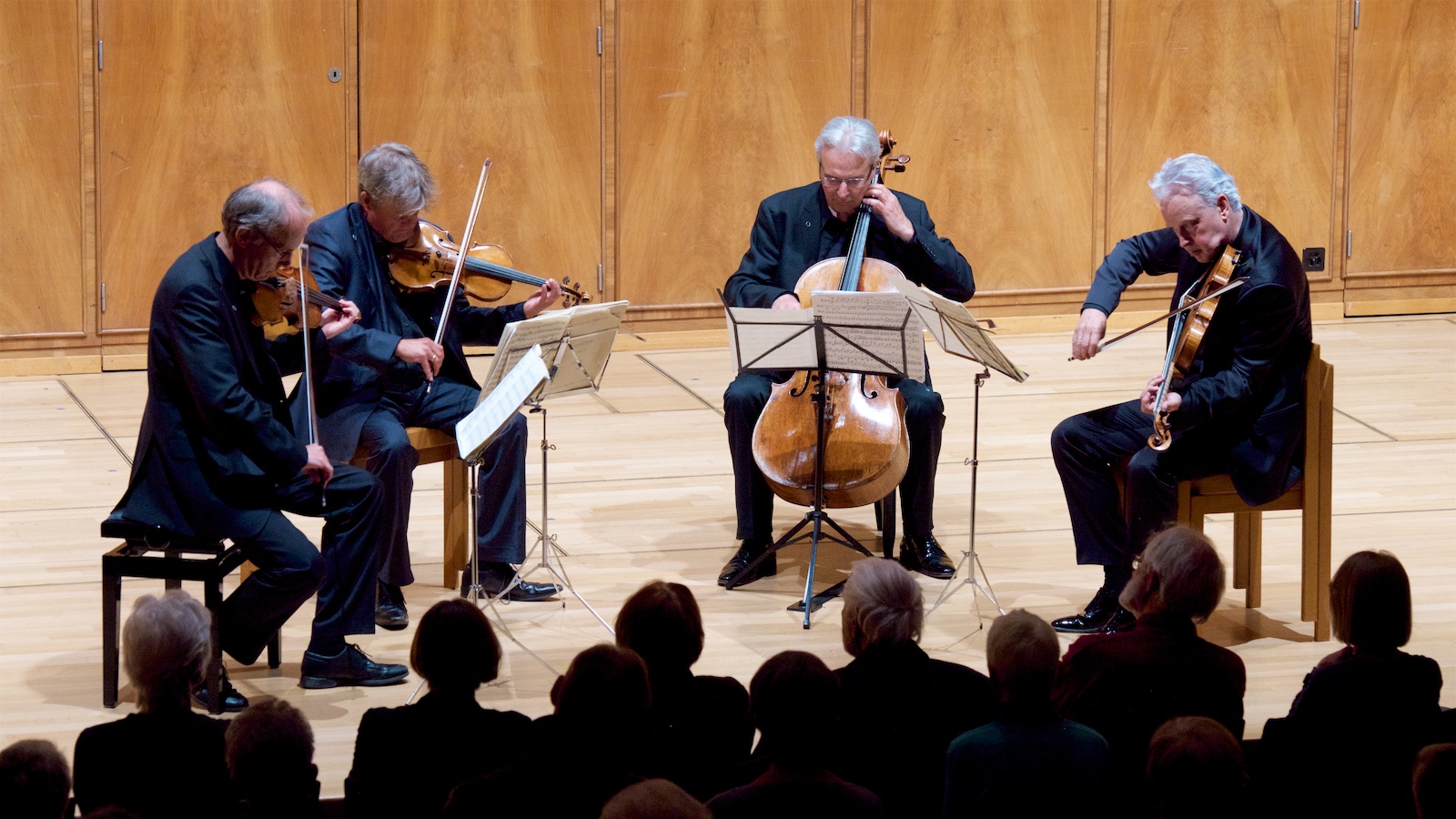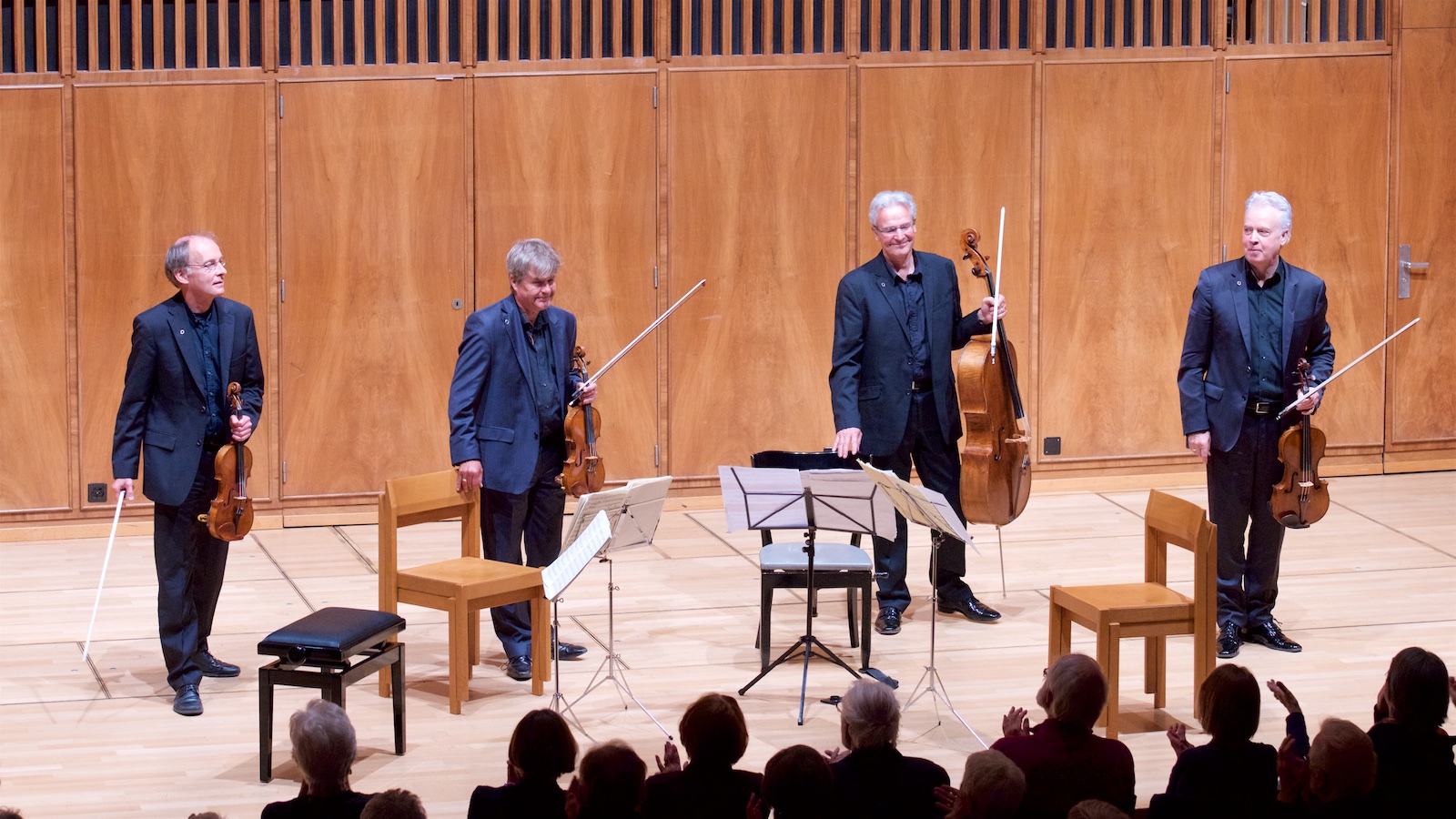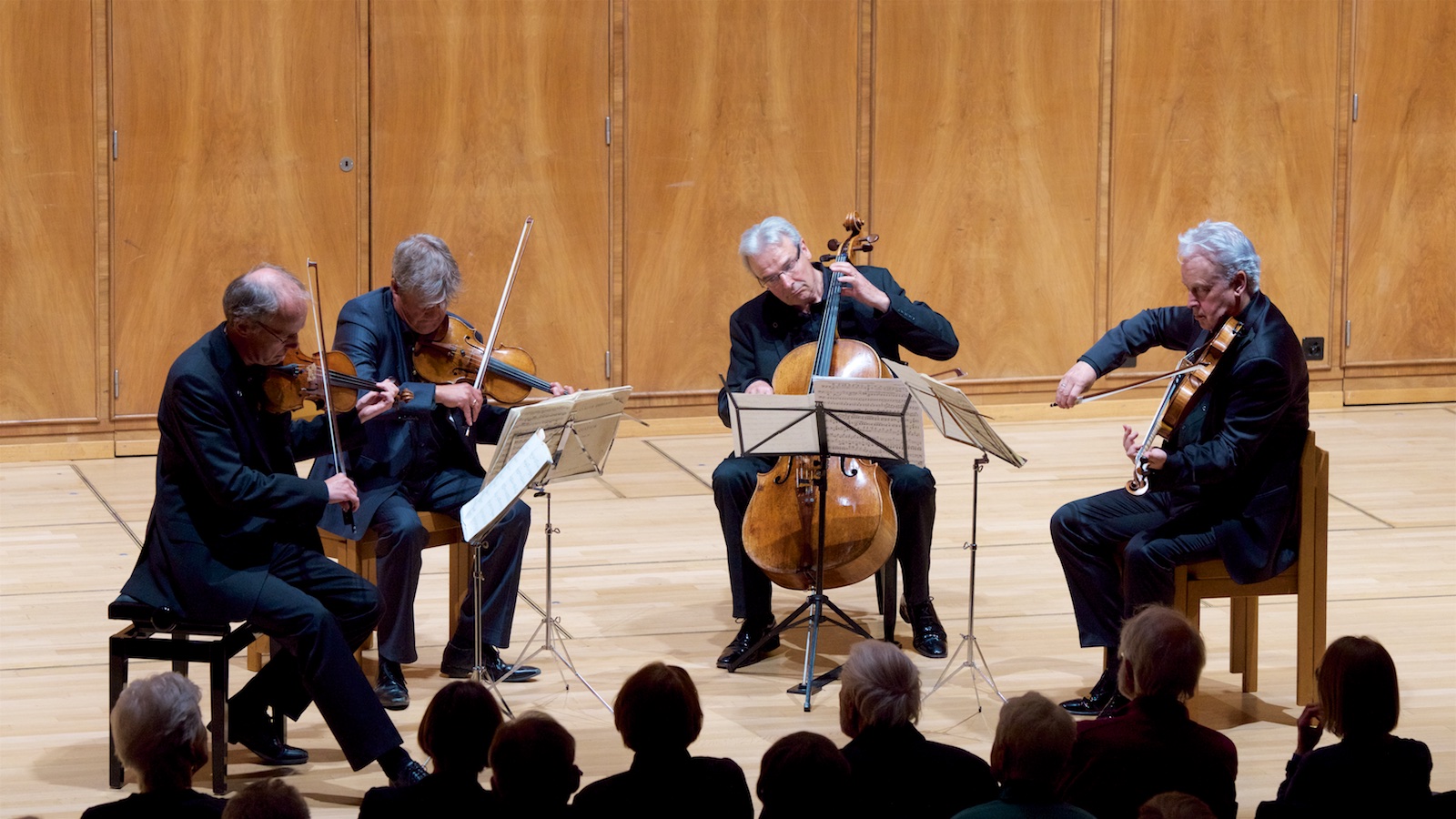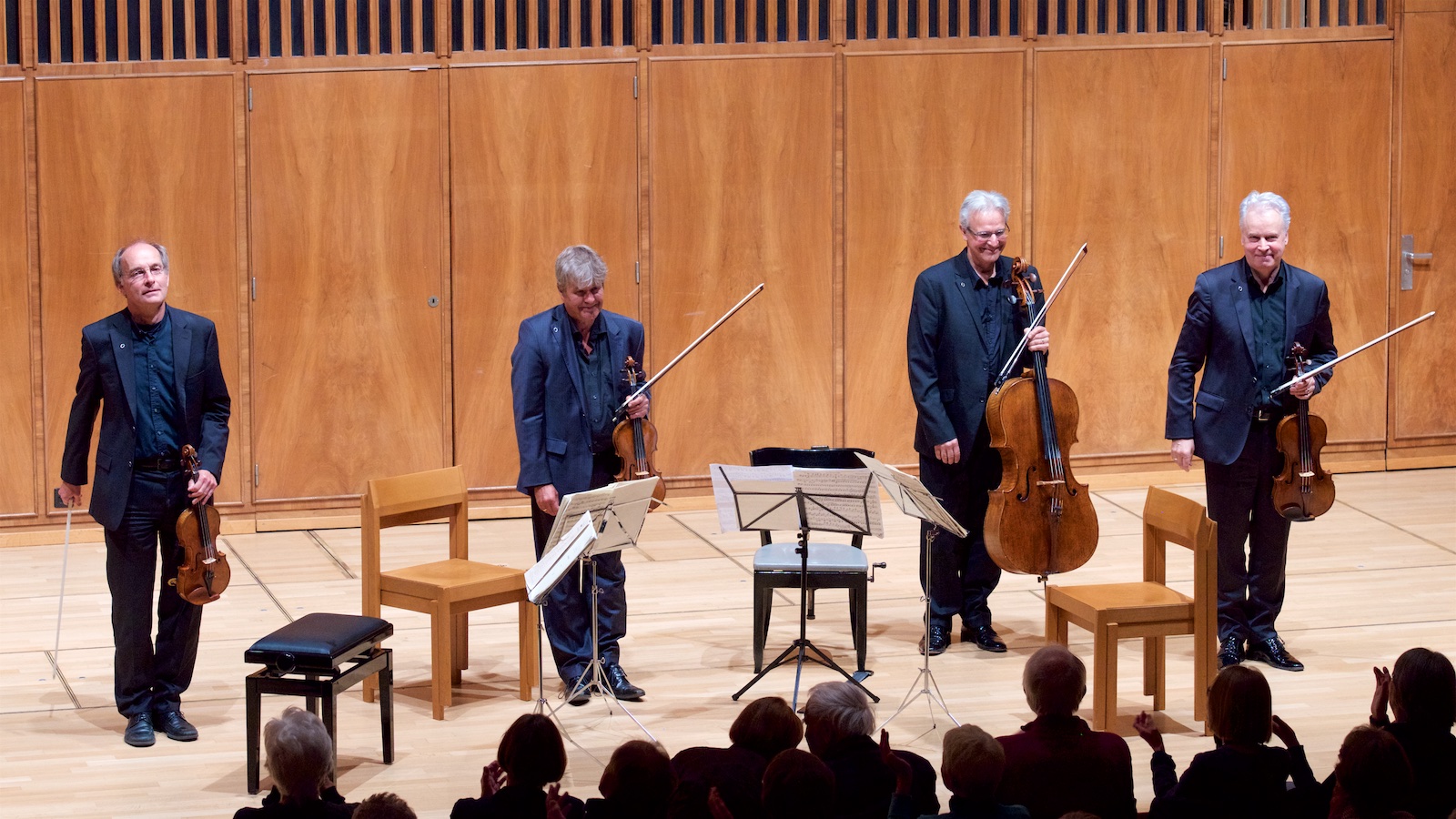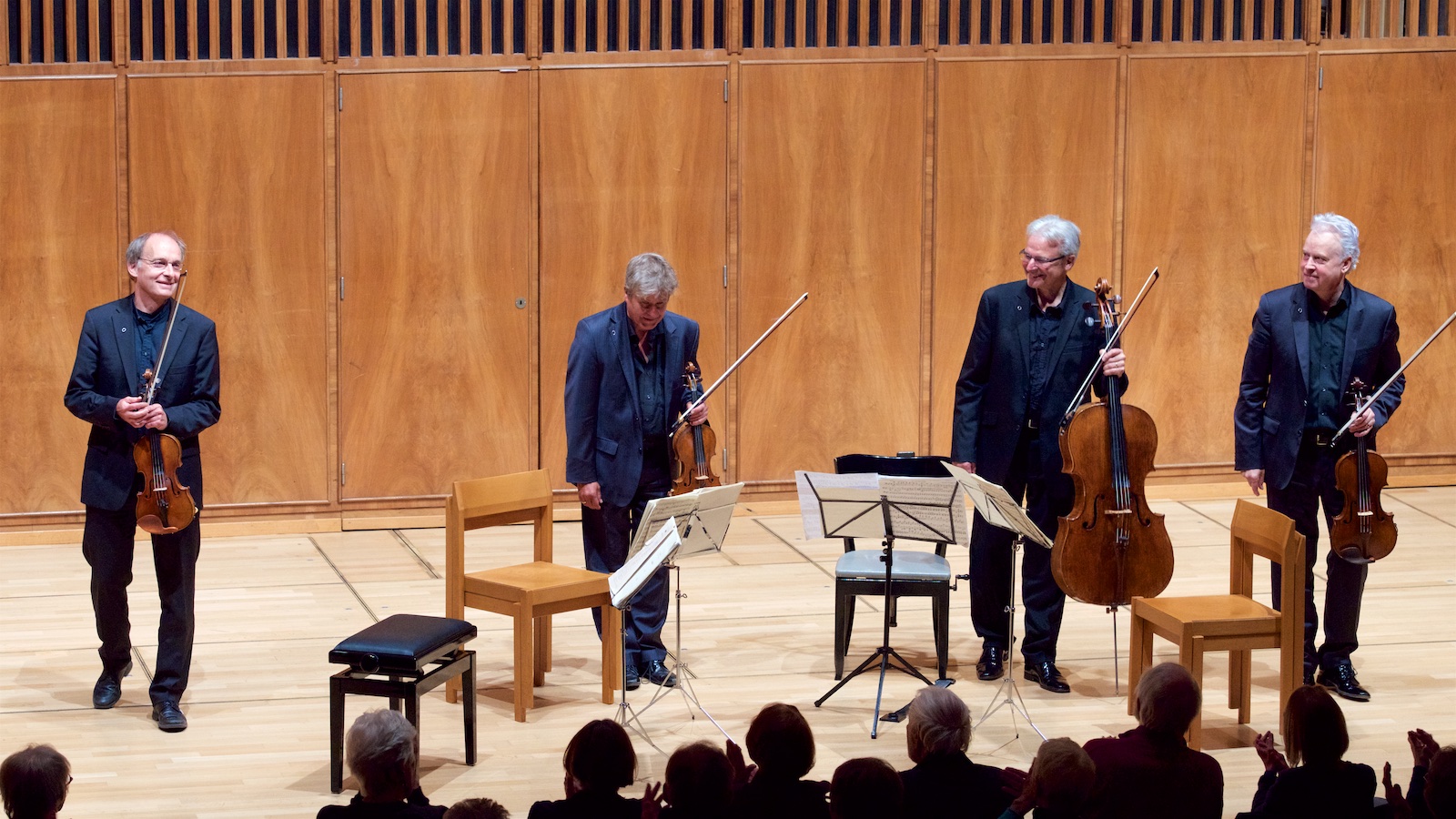Auryn Quartett
Debussy / Mozart / Grieg
Konservatorium Bern, 2018-05-14

2018-05-16 — Original posting
2019-04-02 — Addendum
Ein Quartett am Abend seiner bald 40-jährigen Karriere — Zusammenfassung
Leider scheint sich das Auryn-Quartett jeglichen Einflüssen neuerer Entwicklungen und Erkenntnisse verschlossen zu haben: da war nichts vom frischen Wind, den der Trend zu historisch informierter (HIP) Interpretation in die Aufführungspraxis barocker, klassischer und auch romantischer Werke gebracht hat. Vielmehr schien es, als hätte das Ensemble sich bewusst darauf verlegt, vielmehr beschränkt, das, was sie von ihren Vorbildern und Lehrern vor bald 40 Jahren gelernt und übernommen haben, zu kopieren, zu bewahren. Erst, als die vier Musiker den Schluss-Applaus entgegennahmen, offenbarten sie im freundlichen Lächeln etwas von ihrem liebenswerten Charakter. Es wäre schön gewesen, wenn etwas davon sich auch auf ihre Interpretationen übertragen hätte.
Table of Contents
Introduction
In 1981, four musicians formed the Auryn Quartett:
- Matthias Lingenfelder, violin (*1959, Germany)
- Jens Oppermann, violin (*1960, Germany)
- Stewart Eaton, viola (U.K.)
- Andreas Arndt, cello (Germany)
To this day, through 37 years, the ensemble has retained its original members—a rare exception in the chamber music scene. “Auryn” is the name of a magic amulet in the novel “Die unendliche Geschichte” (The Neverending Story) by the German author Michael Ende (1929 – 1995). In the novel, the backside of the amulet bears the inscription “Do what you like!”—the amulet provides inspiration and fantasy to the holder.
Soon after its formation, the Auryn Quartett won prizes at competitions in Germany and in England. They pursued studies with the Amadeus Quartett (1947 – 1987) in Cologne and with the Guarneri Quartet (1964 – 2009) in New York. Since then, the ensemble has enjoyed an international career, covering a broad repertoire. The most notable recordings by the Auryn Quartett include all 68 string quartets by Franz Joseph Haydn (1732 – 1809), as well as the string quartets by Ludwig van Beethoven (1770 – 1827).
All members of the quartet now work as professors at the Hochschule für Musik in Detmold. For more information on the ensemble see Wikipedia.
Setting
The venue—the big hall in the Konservatorium Bern—was filled fairly well (mostly with subscription audience), but not sold out. My wife and I had first row balcony seats, on the left side edge—seats with excellent view and acoustics.
The stage setup was somewhat inconsistent / diverse, with an adjustable piano bench for the first violinist, followed by two stacked wooden chairs (with backrest) for the second violinist. The cellist had a different chair (his own?), also with backrest, but adjustable height. The violist at the right edge of the semi-circle had the same setup as the second violinist with stacked chairs. This made me wonder whether the two pairs of stacked chairs were originally intended for the four musicians, but were proven inadequate. They didn’t look like ergonomic chairs for musicians anyway. I wondered whether the conservatory (!) didn’t have anything more adequate to offer?
Appearance
From their appearance alone, the four musicians seemed to reincorporate / perpetuate the looks and the attitude of their famous teaching ensembles from 35 years ago. And I’m afraid that this also found its expression in how they performed. In the aftermath, the seat backrests were a bad omen already. Sure, there may be medical reasons for using a backrest, and unavoidably there is some tribute to pay for the 37 years that have passed. Nevertheless, it does not look appealing, nor promising if chamber musicians play while leaning against a backrest.
The point is that there are many, many dozens of excellent string quartets out there performing either standing or either literally or at least “mentally” on the front edge of their seats. Such playing looks and sounds more active and automatically also engages the listener much more. Musicians may claim that they can play equally well at both the front edge and leaning against the backrest—the latter looks passive and immediately puts musicians at a disadvantage.
Interactions
The above may sound overly critical—I should put that in perspective. Young ensembles rely upon close interaction during a performance, in order to ensure exact coordination, as well as a coherent interpretation. With ensembles such as the Auryn Quartett, the members know each other abundantly well: they are aware of each other’s intent, they have long unified their approach to their repertoire. There is much less of a need for constant, close contact. So, from their appearance, it looked as if they had almost completely “internalized” their interaction, communicating mostly through peripheral vision.
This mostly seemed to apply to the two middle voices on their “double-decker chairs”. One cannot really lean back while playing the cello, and as he was seen from the audience, Andreas Arndt certainly was the most open and interactive character while playing. He was showing vivid facial mimics, looking at his colleagues. The other three largely seemed to focus on their sheet music, their playing. What counts in the end, of course, is the result—but still…
Debussy: String Quartet in G minor, op.10, L.85
Originally, Claude Debussy (1862 – 1918) planned to write two string quartets. However, only one materialized in the end: the String Quartet in G minor, op.10, L.85, which he completed in 1893. The composition premiered in the same year in Paris, with mixed reactions from the audience. The four movements are
- Animé et très décidé (4/4, 68=½) – Très animé (6/4, 138=½)
- Assez vif et bien rythmé (6/8, 112=3/8)
- Andantino, doucement expressif (6/8, 80=♪) – Un peu plus vite (3/8, 88=♪) – 1er Mouvement
- Très modéré (4/4, 58=♩) – En animant peu à peu (12/8, 108=♩) – Très mouvementé et avec passion (2/2, 132=½) – Très animé (2/2, 138=½)
I have recently heard this same composition in a live performance—see my earlier report on the concert on 2018-04-22.
The Performance
I. Animé et très décidé – Très animé
My first impression: a full, warm, well-rounded ensemble sound: a seasoned quartet that didn’t take long to acclimatize to the situation in the concert. Maybe that the semiquaver triplets in the upbeats in bars 5 – 9 were standing out a bit too much—but I think that was merely a reaction / compensation for the very first of these triplets in the initial bar going amiss. In subsequent instances, these triplets felt more natural, almost like acciaccaturas (which I think they really are).
I liked the natural musical flow in this movement—though, in the aftermath, I think this is a consequence of the many years of common performance in this ensemble. The articulation was certainly not too light, the sound compact, the transparency moderate. In terms of rhythm and agogics, the performance felt relatively straight, “orthogonal”, rather than featuring the flexibility that some may associate with impressionist music. One should note, though, that Debussy didn’t like the association of impressionism with his compositions. — ★★★
II. Assez vif et bien rythmé
Fairly elegant, fluent—an expression of the ensemble’s routine with such music. I noted the relatively dark sound of the instruments in this ensemble. The long notes in the cantilenas (starting at bar 54, in the G minor section) exhibited an abundant amount of vibrato and a tendency to use portamento. Both were so typical of string quartet playing in the ’70s and ’80s!
With its extended pizzicato sections, the movement is fairly virtuosic. One could also feel the quartet’s experience from the fact that also here, coordination worked well, even with very little visual contact. — ★★★
III. Andantino, doucement expressif – Un peu plus vite – 1er Mouvement
The sound of the instruments was matching perfectly, especially when playing with mutes. For example, the initial solo in the second violin had exactly the same sound character as that of the subsequent “echo” in the viola, except that the latter was a little more voluminous. And the mutes of course made the sound of the ensemble even darker.
The second movement had ended in a really soft ppp. However, within a movement, the artists barely dared taking the volume down to pp, let alone ppp. Rather, the dynamics seemed to cover the limited span between mf and f, maybe ff. And again, the amount, the omnipresence, and the heaviness of the vibrato seemed to point to quartet playing typical of the time when the ensemble was founded. — ★★★
IV. Très modéré – En animant peu à peu – Très mouvementé et avec passion – Très animé
Again, I noted the rather dark sound of the ensemble overall—not just with the cello (an instrument with a remarkably big body, where one expects a dark sound). Technically, the artists had no issues at all with this music. Transparency and rhythmic clarity were OK, though not outstanding. This was a consequence of the rather soft, broad articulation. An emotional rather than analytical performance, in my view. And again, the dynamic annotations were only partially observed at the “soft end”. — ★★★
Overall rating: ★★★
Mozart: String Quartet No.17 in B♭ major, K.458, “Hunt”
1782 – 1785, Wolfgang Amadeus Mozart (1756 – 1791) wrote six string quartets, which he dedicated to Franz Joseph Haydn (1732 – 1809):
- No.14 in G major, K.387, “Spring” — 1782
- No.15 in D minor, K.421 (417b) — 1783
- No.16 in E♭ major, K.428 (421b) — 1783
- No.17 in B♭ major, K.458, “Hunt” — 1784
- No.18 in A major, K.464 — 1785
- No.19 in C major, K.465, “Dissonances” — 1785
The String Quartet No.17 in B♭ major, K.458, “Hunt” has four movements, as most quartets at that time:
- Allegro vivace assai
- Menuetto: Moderato – Trio
- Adagio
- Allegro assai
The Performance
I. Allegro vivace assai
In line with the performance in the Debussy quartet, the articulation was relatively broad, mellow (far from being percussive), even with an occasional tendency towards “belly notes”. Also, staccato was not over-emphasized. The expression was rather solid (especially when compared to recent “HIP” performances). At the same time, sforzati were certainly not over-accentuated (often just barely standing out). The musicians seemed to focus on the large phrases, the overall flow, but there was rather little local expression / Klangrede. The instruments had been re-tuned prior to the Mozart—though, that did little to avoid the impact of the heavy vibrato on the intonation. — ★★★
II. Menuetto: Moderato – Trio
A performance dominated by broad portato articulation, rather slow, placid, with very little, if any dance / Menuetto character. the Trio was lighter, though still only remotely dance-like. Even more than in the first movement, the vibrato affected the intonation, especially with the staccato notes (it eludes me why short notes need staccato at all!). — ★★½
III. Adagio
The slow movement made me realize how much my musical taste & expectation has moved away from the traditional, ubiquitous use of vibrato, especially if it is as heavy as here. To me, it had a serious impact on the intonation—more here than anywhere else. That aside, the artists did use agogics, and the carefully crafted the dynamics within the bigger phrases. But they spent only limited effort on local Klangrede, nor was there any variation (such as extra ornaments) in repeated motifs. — ★★½
IV. Allegro assai
Technically the artists certainly had no issues at all—the coordination was flawless at all times. Yet, the performance was not clumsy, but still rather solid (if not even occasionally somewhat superficial in the short notes): Mozart how it was common 40 years ago. It seems that the artists stuck with their performance style at the time of the ensemble’s inception: none of the newer tendencies appears to have influences their interpretation. They didn’t pick up even traces of what we now know as “historically informed playing”. Decades ago, this was definbitely OK, but by now, it makes the performance sound somewhat careless: — ★★½
Overall rating: ★★½
Grieg: String Quartet No.1 in G minor, op.27
Edvard Grieg (1843 – 1907) wrote three string quartets. The first one, in D minor, is an early work from 1860, and is now lost. Grieg did not complete his third quartet in F major. His second quartet is known as String Quartet No.1 in G minor, op.27. Grieg composed this in 1877/1878, while living on a farm. Wikipedia quotes a relevant letter by composer, to a friend (source given in the article): “I have recently finished a string quartet which I still haven’t heard. It is in G minor and is not intended to bring trivialities to market. It strives towards breadth, soaring flight and above all resonance for the instruments for which it is written.“
The String Quartet “No.1”, op.27, has four movements:
- Un poco andante – Allegro molto ed agitato
- Romanze: Andantino
- Intermezzo: Allegro molto marcato – Più vivo e scherzando
- Finale: Lento – Presto al saltarello
The Performance
I. Un poco andante – Allegro molto ed agitato
The slow introduction: very expressive, emotional, full-sounded, impressive volume. In the main part (Allegro molto ed agitato), some of the quaver motifs were not entirely clear, were partly ” swallowed”, and of Grieg’s rhythmic structures were occasionally blurred. And also here, the artists did not explore the dynamic scope (ppp … ffz) in Grieg’s score. One of the main difficulties here is, not to lose the tension though the long movement with its ruptures, the general rests separating segments, the changes between tranquillo and animato sections.
Overall, I felt that among the pieces in this program the playing style, their fluent, relatively mellow articulation of the Auryn Quartett seemed best suited for the Grieg quartet. This was one of the better movements in that concert. I particularly liked the play with colors in the Più mosso coda with its whirring sul ponticello tremolo accompanying the melancholic melody in the cello. — ★★★
II. Romanze: Andantino
Ah, this excess in vibrato and portamento! The artists did tune again prior to this movement—how little did it help against such fluffy articulation and so much vibrating! In the Allegro agitato part, Grieg doesn’t just write punctuated semiquavers: he specifies a semiquaver, followed by a 32nd rest and a demisemiquaver: this motif appeared “washed out” to a triplet, if not to two semiquavers. The articulation appeared to fall apart, occasionally. The movement sounded close to salon music, was overblown in the lyrical segments. To me, there is some Italianità in this music—and that aspect seemed to be missing here entirely. — ★★
III. Intermezzo: Allegro molto marcato – Più vivo e scherzando
Rhythmically not always as clear and transparent as it could (and should) be. At least, the playing was very active, with verve. The middle part (Più vivo e scherzando) was definitely better, played with engagement and emphasis—at least up to the tranquillo part. — ★★★
IV. Finale: Lento – Presto al saltarello
For an “Italian” saltarello (isn’t it as if Grieg had anticipated Tchaikovsky’s Capriccio Italien, op.45?), this movement should feel lighter. Also, some transitions (e.g., at the change from alla breve to 6/8 time, e.g., after [G], or after [V]) didn’t feel entirely natural. At [W], Grieg starts at pp twice—here, this was mf at best. The ending (starting at [X]) with the final acceleration (twice) to Presto sounded overblown, rather than playful, joyful, if not boisterous. — ★★½
Overall rating: ★★½
Encore — Stravinsky: Tango
One of the most popular compositions for piano by Igor Stravinsky (1882 – 1971) is his “Tango”, which the composer wrote in 1940. It’s the first work that Stravinsky wrote entirely in the States. The composer himself reworked (or was involved in reworking) the Tango for various instrumental settings, such as
- orchestra (3 flutes, 3 clarinets, 2 oboes, 2 bassoons, 3 saxophones, 2 horns, 3 trumpets, 3 trombones, tuba, percussion, piano, guitar, and strings)
- 4 clarinets, bass clarinet, 4 trumpets, 3 trombones, guitar, 3 violins, viola, cello, and double bass
- violin and piano
Other musicians have made arrangements for a large variety instrumental settings. There is also a version for string quartet (e.g., by Wolfgang Birtel, 2010). It may have been this one which the Auryn Quartett selected as encore.
This short piece, with its irony and playfulness suited the ensemble’s playing style very well—it reconciled me with some of the shortcomings in the main part of the program. Thanks, gentlemen!
Conclusion
I wish some of the smile, the amiable character that each of the four musicians showed when accepting applause would have transpired to their performance! It’s too bad that they appear to have locked themselves out of any of the newer tendencies, the insights, the new life that historically informed playing practice has brought to such a wide range of classical music styles and genres! It sadly felt as if they had deliberately and exclusively preserved what they inherited from their teaching quartets.
Addendum — 2019-04-02
I just learned that the Auryn Quartett (not unexpectedly) announced that they will disband after the 2020/2021 season. With this, they will then end a career of 40 years as a quartet—all in the same, initial configuration: a remarkable achievement!




